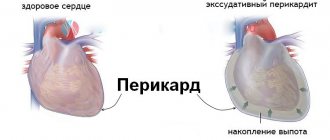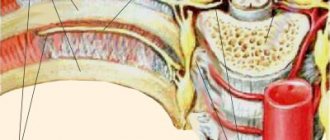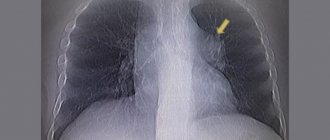Fluid in the lungs - how and from what?
It is normal if a sufficient amount of air enters the lungs, from which they release the oxygen necessary for life.
Serious pathological processes in the organs of the digestive system or in cardiac activity can negatively affect and disrupt the integrity of blood vessels.
As a result, the liquid easily penetrates and fills them. As a result, the amount of air inhaled is significantly reduced, causing tissues and all organs, including the brain, to experience hypoxia - oxygen starvation.
Causes of complications
The accumulation of fluid in the lungs is not an independent disease, but a complication that occurs against the background of the underlying disease.
The root cause of fluid accumulation in the lungs may be:
- Dysfunction of the lymphatic system.
- Endocrine diseases, diabetes mellitus;
- Inflammatory processes such as rheumatism. Pleurisy (inflammation of the pleura) often causes fluid to appear in the lungs.
- Infectious diseases (tuberculosis, pneumonia).
- Problems with cardiac activity. This may be a severe heart defect, which causes weak contraction, as a result of which an unacceptably high pressure is established inside the alveoli.
- Traumatic brain injuries and pathologies.
- Chronic processes in the upper and lower respiratory tract.
- Toxic poisoning, including inhalation overdose.
- Pneumothorax, strokes and chest injuries.
- Malignant formations and not only in the chest organs.
- Acute form of liver cirrhosis.
- Weakened immunity.
- Bronchial asthma.
Fluid in the lungs.
The reasons may lie in bronchial asthma. Fluid in the lungs, the causes and treatment of this concomitant, as well as the underlying disease, can be determined by a pulmonologist only after a comprehensive examination of the patient.
Reasons for the development of the disease
Before you give in to panic and look for signs of a dangerous phenomenon, you need to understand why congestion occurs in the lungs. Doctors tend to divide the causes of pathology into congenital and acquired, which developed under the influence of external factors and lifestyle characteristics.
Causes of the disease that appeared under the influence of congenital and acquired pathologies of the cardiovascular system:
- Atherosclerosis.
- Ischemic disease.
- Heart attack.
- Cardiomyopathy.
Such deviations in the functioning of the system affect the quality of blood flow throughout the body, which cannot pass without leaving a mark on the lungs.
External causes of congestion in the lungs:
- Gas poisoning.
- Internal organ injuries.
- Kidney pathologies.
- Long stay at high altitudes.
- Sedentary rhythm of life.
We must not forget that a failure in pulmonary circulation affects the functioning of most internal organs, since they cease to receive oxygenated blood. Congestion in the lungs is most common in older people. This is explained by the fact that their activity decreases due to age, and concomitant diseases aggravate the picture.
Classifications and symptoms of pathology
Fluid accumulation in the lungs occurs at different rates. The speed of the process is its main characteristic.
There are 3 forms of the disease:
- High rate of fluid accumulation . The sudden onset of the process cannot be cured and ends in death.
- Acute form . Symptoms appear and intensify within 3-4 hours. If the underlying disease is not oncology or hepatitis of the liver, and after providing emergency specialized care, the patient’s life can be saved.
- Protracted form . Develops within a day or more.
If timely treatment is not provided in a prolonged form, pulmonary edema develops.
Depending on the cause of fluid accumulation, edema is divided into several types:
- Hydrostatic . The reason is cardiovascular failure, due to which high pressure occurs and exudate presses on the walls of blood vessels, penetrates through them and enters the alveoli.
- Membrane . Toxic substances have a destructive effect on the walls of the alveoli and capillaries, the liquid penetrates through them and enters the lung tissue.
The hydrostatic form is very dangerous and poses a threat to human life. The second form is considered milder; if you start treatment in time, you can get rid of it. But as the disease progresses, the membrane form worsens and becomes hydrostatic.
Symptoms indicating the presence of fluid in the lungs:
- Oxygen starvation . It manifests itself as rapid breathing, bluish skin color, numbness of the limbs, and the functioning of the nervous system is disrupted. With bilateral swelling, suffocation may occur.
- Pain in the lower chest . The pain intensifies during coughing attacks. After such an attack, small children cry for a long time with a hint of hoarseness.
- Intermittent cough . As the condition worsens, the patient develops an intermittent specific cough, during which mucus and ichor are released. Body temperature is unstable.
- Cough provokes dizziness , increases breathing rate, and nervousness. At this point you may faint.
- Shortness of breath . It occurs unexpectedly, even in a calm state. As the disease progresses, it becomes more frequent.
The strength of the manifestation of the pathology is determined by the complexity and type of the underlying disease, and the amount of accumulated fluid.
Symptoms
Malignant pleurisy is characterized by systematic and slow development. In cases of cancer, the accumulation of water in the lungs occurs over many years. Therefore, in some cases, diagnosing pleurisy helps to detect a tumor and prevent the formation of metastases in the pleura. Read also : lung cancer symptoms and signs.
In the early stages, the accumulation of water does not appear in any way and is not felt by the patient. Most often, the disease is discovered accidentally during a clinical examination.
Over time, a lot of fluid collects in the edematous pleural cavity, and characteristic symptoms appear:
- heaviness in the chest, feeling of constriction;
- sensation as if a foreign object had entered the lung;
- aching and stabbing pain in the area of the diseased lung;
- shortness of breath even with little physical exertion, a “lump in the throat” is felt;
- hacking cough that does not go away for a long time;
- low-grade body temperature;
- secretion of thick sputum.
Pulmonary edema is an extremely dangerous condition, the symptoms of which develop very quickly, within a few hours. Why is liquid dangerous in this pathology? Manifestations of pulmonary edema can cause an attack of suffocation, which without timely help can even result in the death of the patient.
Typical signs of water accumulation depend on the amount of fluid in the respiratory organs and location.
There are several typical manifestations of the disease:
- increasing shortness of breath, first from physical activity, and then at rest;
- general weakness, decreased performance;
- cough with mucus and foam from the nose and mouth;
- a feeling of pain in the lower or lateral region of the sternum (pain increases with physical activity or coughing);
- breathing problems (gurgling sounds and wheezing are heard);
- dizziness, lightheadedness;
- bluish or pale skin;
- numbness of hands and feet;
- chills, constantly feeling “chill”;
- increased sweating, cold sticky sweat;
- tachycardia (rapid heartbeat);
- increased nervous excitability.
If such symptoms appear, it is necessary to begin treatment immediately, remove water from the respiratory tract if possible, and carry out procedures to restore breathing in order to avoid serious consequences.
Important! The appearance of copious pink, frothy sputum means that the patient needs urgent medical attention. If the patient is not helped in time, this can lead to death.
Diagnosis of fluid accumulation in the lungs
Fluid in the lungs, causes and treatment are determined by diagnosis. Studies are prescribed depending on the patient’s condition and are carried out in several directions.
Both lungs are thoroughly studied:
- external examination (in some pulmonary diseases, changes in the chest are observed), pain points are determined;
- fluorography;
- Ultrasound;
- carry out laboratory tests of pulmonary exudate.
A detailed blood test is performed:
- the amount of gases in the composition is estimated;
- the presence of malignant tumors;
- coagulability.
The general condition of the body is assessed and the underlying disease that caused the fluid accumulation is found.
Pay special attention to the liver, kidneys, and cardiac activity.
For this purpose they do:
- general urine analysis;
- Ultrasound, CT, MRI.
Based on the data obtained, the doctor must make sure that fluid is actually accumulating in the lungs and understand why this is happening. In particularly complicated cases, he prescribes additional research.
Correct diagnosis
If you suspect a lung pathology, it is important to consult a doctor promptly for help. A competent specialist will diagnose and select the necessary treatment.
Measures for diagnosing congestion in the lungs are as follows:
- Taking an x-ray.
- Analysis of sputum composition.
- Assessment of the state of the cardiovascular system.
- Analysis of urine.
Congestion in the lungs is clearly visible on an x-ray; the expansion of the pulmonary artery will not escape the attention of the doctor; the specialist will also see an increase in capillary pressure above 20 mm Hg. Art.
By collecting the results of all examinations, the doctor will determine the stage of the pathology and ways to eliminate it, which will allow the person to return to health.
General treatment regimen
Fluid in the lungs, causes and treatment are determined based on diagnostic results.
The amount of effusion influences treatment methods:
- Operational path . If the volume exceeds 350 ml, a pleural puncture is performed (puncture of the chest, insertion of a special tube and removal of effusion).
- Conservative way . Drug therapy.
Drug treatment includes:
- inhalations, alcohol and (or) oxygen;
- drugs that dilate the bronchi;
- painkillers;
- anti-inflammatory;
- antibacterial;
- diuretics.
At the same time, they try to get rid of the underlying disease.
Treatment methods
Treatment of congestion in the lungs comes down to two options:
- Surgical intervention.
- Drug therapy.
It is necessary to resort to surgery in cases where the disease is caused by an aneurysm or heart defects. The main goal of any treatment is to eliminate the root cause of the disease, which makes it possible to eliminate its consequences, especially if you consult a doctor in a timely manner.
When selecting medications, you cannot act independently; the correct combination of drugs must be selected by a doctor. Drug therapy includes a whole range of drugs, the ratio of which is determined by a specialist based on diagnostic results.
If pulmonary edema has acquired life-threatening proportions, the patient is immediately hospitalized. In a hospital setting, fluid is pumped out of the lungs and the patient is allowed to breathe pure oxygen.
Elderly people or bedridden patients, who are especially susceptible to the development of congestion in the lungs, are recommended to undergo physiotherapy procedures. This will artificially maintain blood circulation in the lung area.
Treatment for certain diseases and conditions
The rate of recovery of the patient largely depends on the effectiveness of treatment of the primary pathology - the cause of the appearance of fluid in the lungs.
For pneumonia
Only comprehensive treatment can relieve swelling and defeat the inflammatory process.
In this case, doctors prescribe:
- Antibacterial drugs (spiramycin, levofloxacin). At a severe stage, it is taken in the form of injections, then switched to tablets.
- expectorants (theophylline, salbutamol, fenoterol) and long-acting expectorants (salmeterol, teopec). Inhalations with Lazolvan and Berrodual are recommended.
- Immunostimulants , vitamins;
The patient's inability to breathe on his own forces ventilation of the lungs.
For oncology
Treatment of the disease in the presence of cancer in the body is determined by the following:
- location and degree of cancer (in especially hopeless situations, they try to alleviate symptoms);
- volume of liquid and where it is located.
Oncology therapy is a long process with an unpredictable outcome, and is permissible in two cases:
- a small amount of liquid, the process does not progress;
- There is no possibility to remove the tumor surgically.
In other cases, surgery to remove the tumor.
For leukemia
Therapy using existing methods is carried out in two directions:
- leukemia treatment;
- removal of effusion from the lungs.
With leukemia, lung diseases significantly worsen the patient’s condition and directly lead to death.
For heart failure
Sequence of treatment:
- inhalation to extinguish foam in the lungs;
- pain relief, use quite strong drugs, including narcotics;
- suppression of psychomotor activity with antipsychotics;
- removing unnecessary fluid by taking diuretics.
The measures taken make it possible to reduce pulmonary pressure and reduce the flow of blood through the venous vessels, which means a decrease in pressure in the pulmonary circulation.
After this, they begin to fight heart failure:
- Prescribe medications depending on the complexity of the disease;
- broad-spectrum antibiotics if the cause of deficiency is an inflammatory process.
Therapeutic therapy is carried out in a hospital setting.
For injuries
Fluid in the lungs may appear due to injury:
- heads;
- sternum.
First, epidural analgesia is given urgently.
Treatment plan:
- oxygen and alcohol inhalations;
- physiotherapy.
If complications develop with a sternum injury, and with a head injury, always perform:
- drainage in the chest cavity;
- restriction of fluid intake.
If necessary, give an intravenous injection of ethyl alcohol.
For brain disorders
Therapy involves:
- use of portable cameras;
- furosemide injections to lower blood pressure.
During an attack, they breathe through gauze soaked in alcohol, which blocks the accumulation of foam in the alveoli.
For renal failure
If the kidneys are damaged and are unable to remove fluids from the body, this leads to edema, including in the lungs.
Therapy is aimed at normalizing:
- acid-base balance;
- water-electrolyte balance.
Treatment is accompanied by diet.
After surgery
After the operation, in order to prevent the development of pulmonary edema, a course of therapeutic exercises is prescribed, which promotes:
- increasing lung volume;
- improving blood circulation in the small and large circles;
- strengthening muscles.
In case of urgent removal of swelling, use:
- oxygen masks;
- glucocorticoids, urea drugs to extinguish foam;
- drugs that dilate the bronchi;
- drugs that relieve myocardial ischemia;
- in difficult situations, they are connected to artificial respiration.
After stopping the exacerbation, therapy is carried out based on diuretics, sedatives and antihistamines.
For cirrhosis of the liver
Liver cirrhosis often stimulates the accumulation of effusion in the lungs, a phenomenon called hepatic hydrothorax. Only a liver transplant can radically change the situation towards restoring health.
In another case, maintenance therapy is carried out:
- teracentesis, for the purpose of evacuating fluid from the pleural cavity;
- diuretics (spironolactone, furosemide);
- salt diet.
Prevention of pneumothorax is achieved through the procedure of pleurodesis (prevents the occurrence of pleural effusion).
In old age
Treatment of older people is carried out in a hospital.
The technique is chosen taking into account the patient’s age and factors:
- severity of the underlying disease;
- presence of concomitant chronic diseases;
- general condition of the body.
Particular care is required in case of surgery. After treatment, the elderly patient is under clinical observation for 2-3 years.
Treatment and prevention
As noted earlier, it is imperative to treat pulmonary congestion immediately after diagnosis.
Regardless of the stage of the disease, it is best to use hospital treatment, and in case of any complications, resuscitation measures are used, in particular, using an artificial respiration apparatus and oxygen masks. The patient is obliged:
- undergo an ECG,
- take an x-ray of the lungs,
- undergo an ultrasound of the heart.
Inflammation is determined by biochemistry or a local blood test.
Before prescribing treatment, it is necessary to identify what causes the stagnation. If the underlying cause is heart failure, then it makes sense to use cardiotherapy.
Therapy
If the nature of the disease is infectious, then a complex of antibacterial therapy is used. It effectively reduces the influence of microbes on lung tissue, reducing inflammation and thereby relieving congestion.
In addition, drugs are prescribed to thin sputum clots (Bromhexine, ACC). Treatment of congestion in the lungs is carried out, in addition to the use of mucolytics, with the use of herbal extracts (plantain, coltsfoot, thyme), which ensure normalization of blood flow in the lungs and reduction of inflammation.
It is also necessary to include vitamins that increase immunity in the treatment regimen (Vitrum, Supradin). Therapy is often supplemented by the prescription of diuretics to relieve swelling and normalize fluid metabolism in the body. They ensure the removal of toxins and pathogenic organisms from the body that cause stagnation.
If a person suffers from congestion in the lungs, which results in weakening of the heart muscles, then it is imperative to follow all the doctor’s recommendations and undergo the full course of treatment prescribed by a cardiologist or pulmonologist. After all, the result of untreated congestion in the lungs can be cardiac arrest.
Warning
In addition to medicinal methods, dietary nutrition based on the exclusion of salt from the diet will help to reduce the risk of developing further complications. This will help reduce swelling and normalize the flow of blood and lymph in the lung tissue. It is very important to include foods with plenty of carbohydrates, vitamins and protein in your diet. This will provide the necessary vital energy to the cells.
During an exacerbation of congestion, if the patient is forced to adhere to bed rest, even while lying down, it is worth performing as many movements as possible - turns, lifting the torso, shoulders, arms.
This helps stop the development of stagnation processes. If a person does not have the strength to do the exercises himself, then he needs to turn to loved ones for help. The patient should not be in one position for a long time, because this will only complicate breathing and the functioning of the chest organs.
A specialist in physical therapy and breathing exercises can teach you basic exercises. It is very important to breathe correctly; to develop respiratory function, you can periodically inflate a balloon or breathe into a glass of liquid using a cocktail straw.
The listed exercises help enrich the respiratory system with the required amount of oxygen. Another benefit is the increased movement of the chest, which prevents congestion. The patient is recommended to be as active as possible to combat pulmonary congestion at any stage of the disease.
Treatment may also include:
- mustard plasters,
- medical banks,
- physiotherapy,
- tapping massage.
It is also recommended to add hot tea with honey or lemon to the course of therapy. It perfectly expands and strengthens the walls of blood vessels. Another important property of this drink is to counteract the appearance of phlegm.
Congestion in the lungs is not a death sentence. Drug therapy, as well as increased breathing and minor physical exercises can improve blood flow in problem areas of the lungs and relieve symptoms of congestion.
Traditional medicine in the treatment of fluid accumulation in the lungs
The effectiveness of traditional methods of treatment has been proven in practice. In addition, many medications are made from beneficial plants. Taking folk remedies cannot be done uncontrolled.
Pre-requisite:
- consult a doctor;
- read the contraindications.
Pulmonary diseases cannot be cured with herbs alone, but they can speed up and strengthen the healing process. Experts recommend combining professional and traditional medicine.
Honey tincture
Tinctures made from honey and specially selected herbal mixture are useful for many diseases, including lung problems. 1st option. Has a strong expectorant effect.
Place in the container:
- a glass of viburnum berries;
- linden flowers, plantain leaves, knotweed - 2 tbsp. l.;
- 2-3 sheets of coltsfoot.
Everything is filled with 0.5 liters. vodka, add 50 ml. honey. Mix everything thoroughly, the honey should completely dissolve. Leave in a dark place for 2 days. Use 1-2 tbsp. l. 3 times a day. 2nd option. Recommended for severe, intermittent cough that prevents you from falling asleep.
Composition of herbs:
- 1 tbsp. motherwort;
- 1 tbsp. valerian;
- 2-3 tbsp. Ivan-tea.
Pour in 0.2 liters of vodka and leave for 2-3 days.
Then they take a glass and place in it sequentially:
- 1 tbsp. honey;
- 3-4 tbsp. infusion;
- 1 tsp lemon juice.
Mix everything thoroughly until the honey is completely dissolved.
The infusion prepared in this way is taken strictly before bedtime, covered with a warm blanket. After sleep, consume 1 tbsp. honey and a slice of lemon.
Decoction of anise seeds
Solutions based on anise seed:
- cleanses the bronchi and lungs of accumulated mucus;
- tone the bronchi;
- relieve inflammation;
- increase secretion of the respiratory tract;
- stimulate kidney function.
Procedure for preparing the decoction:
- put 1 tbsp into the container. anise seeds;
- pour 0.2 liters of boiling water;
- cook for 15 minutes;
- cover with a towel and leave for 20 minutes;
- add 1 tbsp. l. cognac and honey.
Take 1 tbsp decoction. l., 4 times a day.
Aloe vera medicine
Aloe vera (agagave) activates the immune system and kills pathogenic microorganisms. There are several recipes for preparing medicine that is used for lung diseases.
Method 1, required:
- 250g crushed agave leaves;
- 200ml olive oil;
- 150g honey.
Mix the ingredients and heat. Store the mixture in a dark place. Take 1 tsp, an hour before meals. Duration – 5 days.
Method 2, preparation order:
- extract juice from 250 g of plant leaves;
- add 0.7 ml of red wine and 0.5 liters of honey;
- mix the ingredients thoroughly;
- leave in a dark place for 5 days.
Use the prepared mixture within 5 days. Aloe vera-based inhalations are not recommended for fluid accumulation in the lungs.
Parsley
Parsley is great for removing excess fluid and helps relieve pulmonary edema.
A decoction of herbs prepared in milk is considered beneficial:
- 800 g of leaves are poured into 1 liter of milk;
- do not bring to a boil, but keep on low heat until the volume is reduced by half.
Use 1 tbsp. decoction every half hour.
Onion juice
Onion medicines help:
- destruction of pathogenic microorganisms;
- strengthening the immune system;
- sputum discharge;
- improved breathing.
Preparation of the mixture for external and internal use:
- take onion and goose fat in a 1:1 ratio;
- grate or finely chop the onion;
- melt goose fat;
- mix the ingredients.
Admission rules:
- rub the chest area immediately before bed;
- the chest is insulated with a scarf or handkerchief and left until the morning;
- after sleep, on an empty stomach, eat 1 tbsp. mixtures.
The duration of treatment is until recovery.
Blueberry root
A decoction based on blue cyanosis has the following effect:
- expectorant;
- sedative;
- diuretic;
- normalizes blood pressure.
Cooking method:
- crush the cyanosis root and place it in a container;
- pour water at the rate of 6 g of plant - 20 ml of water;
- keep the closed container with the mixture in a water bath for at least 30 minutes;
- strain.
Keep the prepared solution in a cool place, take 1 tbsp. after eating.
Flax seeds
Medicines made from flax seeds are indicated for the prevention of pulmonary diseases and produce the following effect:
- anti-inflammatory;
- normalizes blood pressure;
- prevents the development of cancer;
- restores liver function;
- increases immunity;
- strengthens the upper and lower respiratory tract.
The recipe is quite simple:
- crush 3 tsp. seeds;
- add 1 tsp. honey;
- mix.
The induced composition is taken one teaspoon 3 times a day for 14 days. Then you need to take a break for 7 days and repeat the course if necessary.
Diet for fluid accumulation in the lungs
Fluid in the lungs, causes and treatment depend on the quality and regularity of nutrition.
Nutritionists advise adhering to the following diet plan:
- drink enough water and juices (at least 1.5 liters), but reduce tea and coffee intake;
- do not pass it on before going to bed, give the body a rest at night;
- eat small meals every 2-3 hours;
- limit sweet, fatty, salty foods;
- diversify your diet as much as possible (vegetables, fruits, meat, fish).
A proper diet will strengthen the immune system and eliminate asthma attacks.
Physical activity during treatment
A set of non-loading, specially selected exercises allows you to improve the rehabilitation process:
- Hands along the body. As you inhale, we raise our hands, as we exhale, we lower them.
- Similarly, only the arms are spread to the sides.
- Lying on your back position. Alternately bending the left and right legs at the knee joint.
- Lying on your back and resting your elbows on the floor, try to lift your chest.
Repeat each exercise 3-4 times. The pace is average. As the condition improves, the loads are increased.
Prognosis for fluid accumulation in the lungs
The life prognosis depends on the complexity of the disease and the general condition of the patient’s body. Timely treatment and correctly identifying the main cause of fluid accumulation in the lungs contribute to a speedy recovery without consequences. In advanced situations, when a large accumulation of fluid leads to tissue hypoxia, in the absence of proper care, lethal care is possible.
Author of the article: Elena Popova
Article design: Oleg Lozinsky











